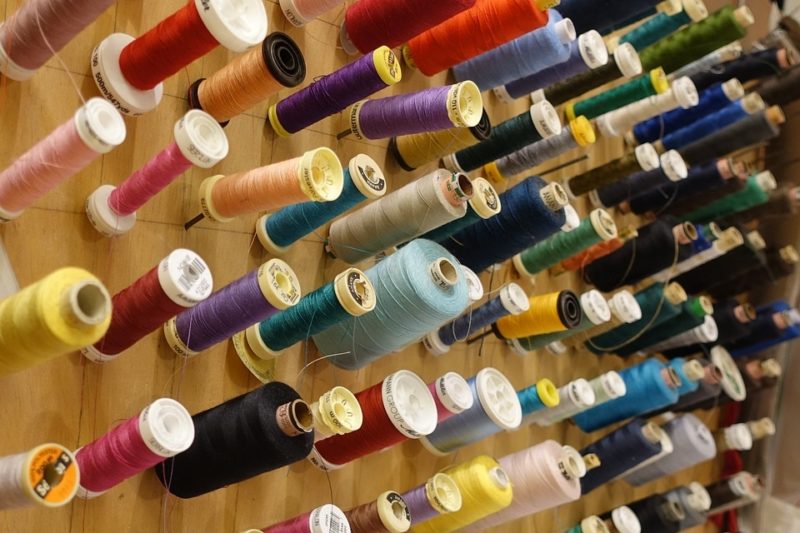You can learn how to make a sewing thread holder in three steps. We’ll use wire and nails for this project, and it can hold more than a hundred spools! We’ll also talk about the proper way of storing threads to help them last longer.
Speaking of threads, do you already know how to use a cone thread on a sewing machine? It’s an excellent way to have more thread in one setting, so you don’t need to constantly replace the spool once you run out during sewing a large project.

How Do You Make A Homemade Thread Holder?
Step 1. Prepare the structure
- Prepare a piece of galvanized wire according to the size you want to hold as many threads as possible (e.g., a 46 by 18-inch piece of wire can hold around 200 thread spools)
- Lay the wire over a flat surface and straighten the bends
- Make prongs by cutting and bending every other wire in a row
Step 2. Design the thread holder
- Clean the thread rack with acetone or wash it with dish soap
- Spray paint the thread holder with your preferred color
- Cover the wire ends with rubber caps or use wire coating
- Slide a fabric piece over the wire prongs so they’ll poke through the material
Step 3. Add the nails for hanging the threat holder
- Clean four roofing nails and spray paint them to match the sewing thread holder
- Find the studs on your wall by knocking and waiting where the sound sounds solid
- Hammer two nails into two studs, with fabric on top of each nail
- Hang the sewing thread holder via any horizontal wires, so position the upper nails several inches below where you want the holder’s top will be
How Do You Store Sewing Threads?
Rubber bands
Attach your bobbin to the spool with rubber bands or any elastics such as hair ties.
Household organizers
Use mason jars, food organizers, pillbox, and even ice trays to sort and arrange your thread spools.
Keyring holders
Hang sewing threads on keyring holders for easy access.
What Is A Thread Holder Called?
A thread holder is also called a spool stand, spool holder, thread stand, and even cone holder. It is typically built into the sewing machine to position the thread during sewing. This way, the thread will run into the sewing machine smoothly without tangling or breaking. However, your thread holder might be only compatible with a particular thread spool size or shape, so you need to get a separate thread stand for some projects.
Read how to use large spools of thread on the sewing machine to know some DIY solutions if you’re using big thread spools.
How to make a thread stand at home
- Glue a nut on a CD case base
- Cut a hanger’s lower side corner and above its hook to mimic the hooked stick of a thread stand
- Insert the hanger into the nut straight end in
- Insert the thread spool on the spindle of the CD case and hook the thread end to the hanger
- Alternatively, find a cup that is compatible with your thread spool’s size
- You can also cut a plastic bottle near the base on one side and pass the thread through the bottle opening
How Do I Keep My Thread Spools Neat?
- Segregate each thread by usage, e.g., machine sewing, hand sewing, embroidery
- Separate each thread according to fiber type, e.g., cotton, polyester, etc
- Group the threads on how they are wound, e.g., cones, spools, or skeins
- Organize the threads into warm and cool colors
- Use a thread rack for the threads that you often use for easy access, and place it in the sewing area
- Place the stock threads in boxes and drawers to keep them from getting dirty
How Long Does Sewing Thread Last?
It’s impossible to mention a specific lifespan for a sewing thread. It can be anywhere from 10 to 50 years, depending on how you store your threads. Furthermore, some threads are made of better quality while others are more brittle. Opt for trusted thread brands and if you store threads, buy synthetic fibers that won’t deteriorate quickly.
To know if your thread is still usable, hold a foot of it between your hands. Then, pull your hands apart and check if the thread won’t snap. If it does, it’s best to use another thread for your project.
Does sewing thread expire?
Sewing threads can expire, but one can’t mention a specific date for when it will happen. Apart from getting high-quality threads, avoid storing your sewing thread in a place where it can collect dust particles or even anywhere humid. You also don’t want to expose threads to sunlight that can fade their colors.
When to replace or throw out sewing thread?
- Discoloration and bleaching
- Weakness and brittleness
- Breaking and disintegration
What to do with old sewing thread?
- Basting and tacking
- Thread tracing
- Filler and stuffing
Conclusion
And that’s it! We just learned how to make a sewing thread holder, and it’s surprisingly easy with a wire that you’ll bend to make prongs and then hang on the wall with nails. You can also stash your threads on keyring holders and household organizers.
Overall, it’s essential to take care of your sewing threads away from humidity, sunlight, and dust. Good-quality ones can last more than a decade, but when you notice signs of degradation and discoloration, it’s time to replace your thread.
